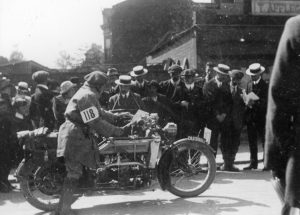Williamson Flat Twin
The bikes that Billy Williamson built were some of the most distinctive and unusual in the years before the First World War, if not the most successful. The small firm from Coventry in the English Midlands assembled big 964cc flat twins, powered by an engine that the better-known Douglas firm of Bristol had originally developed for use in a four- wheeled cyclecar.
Williamson was a larger-than-life character who had been managing director of the Rex firm, before resigning in 1911 along with his brother Harold, who had been the sales manager. Harold went to work for Singer but Billy set up on his own, backed by William Douglas, whose firm specialized in building 350cc flat twins with cylinders running along the line of the bike. Douglas had also developed the larger, liquid-cooled flat twin engine for the cyclecar, and was keen to recoup some of the development costs by seeing it used in a motorbike too.
The 964cc flat twin engine was built by Douglas in Bristol before being transported to Williamson’s Coventry base. Although designed for a cyclecar, it was well suited to two-wheeled use.
The Williamson was not the fastest of large- capacity bikes, but its 50mph (80km/h) plus performance and basic brake system ensured excitement.
Crank-start arrangement
Douglas built the engines and dispatched them to Coventry, where Billy Williamson was based. He was soon joined by Harold as a test rider. The engine was a side-valve unit whose cyclecar origins were revealed by its starting arrangement, which was not a kickstarter but a protruding dog to which a detachable crank handle was fitted. The two- speed Douglas gearbox was operated by a hand lever, in conjunction with a foot clutch.
The Williamson was a fairly stylish and well- built machine whose twin-downtube frame held a Douglas-Druid front suspension arrangement with twin springs held in tension. Elsewhere the chassis was rather basic, with no rear suspension and a brake system that comprised no more than a simple, bicycle-style front stirrup, with blocks pressing on the wheel rim, and at the rear a contracting band worked by a heel pedal.
Williamson improved the bike in the couple of years following its introduction in 1912, notably by adding a kickstarter and an optional three-speed gearbox. The firm also developed an air-cooled version of the twin, which sold for £75, a saving of £7 over the liquid-cooled model. But the start of the First World War saw the demise of the Williamson Flat Twin, because production was stopped: after the war the Douglas engine was no longer available.
Billy Williamson did not give up, and redesigned the bike to take a 980cc side-valve V- twin engine from JAP of north London. The new bike was due to enter production in 1920, but then Billy Williamson suffered a fatal heart attack, after which the firm closed down. One of the British bike industry's great early characters had gone, and with him his dream of a new generation of Coventry -built machines.
Douglas - The Flat Twin Firm
Bristol-based Douglas, the company that provided the 964cc liquid-cooled engine for the Williamson, was known for its smaller flat twins, 350cc air-cooled units that also had cylinders in line with the bike. These side-valve motors produced only a few horsepower, but the Douglas performed well, partly due to its light weight of less than 1751b (79kg). In 1912 the firm finished first and second in the Isle of Man Junior TT, and won the 350cc class at the Spanish Grand Prix.
Douglas had begun building flat twins in 1906, after acquiring the right to manufacture bikes build under the Fairy name. Production continued until the late 1920s with few changes, although an optional two-speed gearbox was offered from 1911, and later a clutch too. The Douglas was popular with First World War despatch riders, because of its lightness and agility in bad conditions. Douglas continued with flat twins and introduced the stylish 350cc Dragonfly in 1955, but production ended two years later.
Williamson built a cheaper air-cooled version of the twin as well as this original liquid- cooled model.
Production ended with founder Billy Williamson’s death in 1920.
Williamson Flat Twin Specification (1913)
- Engine Liquid-cooled side-valve four-valve flat twin
- Capacity 964cc (85 x 85mm)
- Maximum power Not known
- Transmission Two-speed, chain final drive
- Frame Steel twin cradle
- Suspension Girder front; rigid rear
- Brakes Stirrup front; contracting band rear
- Weight 300lb (136kg)
- Top speed 55mph (88km/h)



















0 comments: